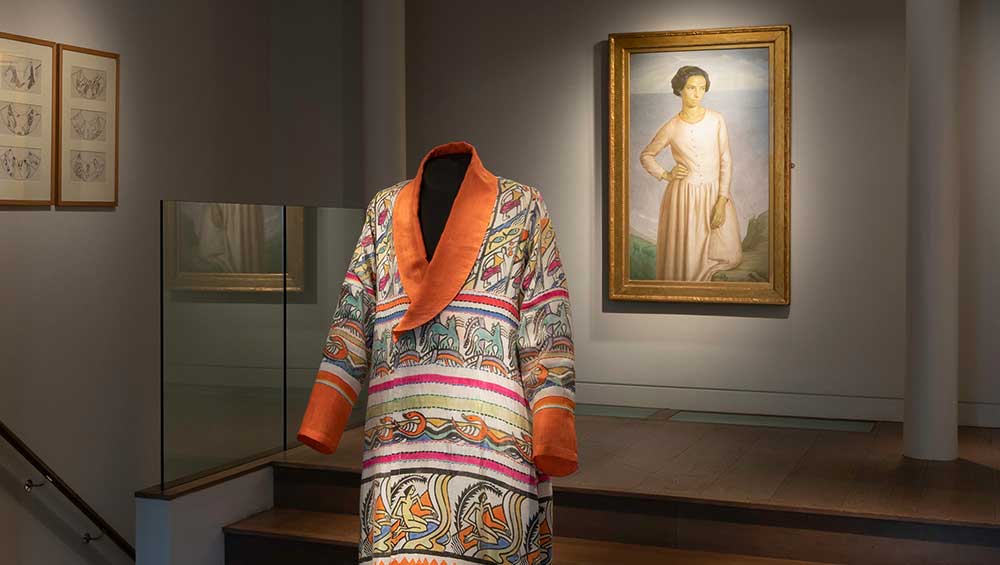
Percy Wyndham Lewis, Robe, 1913-14. Embroidered and block-printed silk robe. Background: Henry Lamb, Edie McNeill, 1911. Oil on canvas. On loan courtesy of Southampton City Art Gallery. Copyright The Artist. Reproduced by kind permission of the Henry Lamb Estate. Installation view, Augustus John and the First Crisis of Brilliance, Piano Nobile, London 2024. Photo courtesy of Piano Nobile, London.
Piano Nobile, London
26 April – 13 July 2024
by ANNA McNAY
There is something really rather special about turning up at a gallery, seeing work by an artist you haven’t heard of, saying their name aloud, questioningly, to your friend, and having a voice pipe up behind you – which turns out to be that of the gallery researcher, Luke Farey – offering a full background of the artist, and his model, in an infectiously enthusiastic manner. The artist was Derwent Lees; the model, who went on to become Lees’s wife, a young woman who was to go by various names over the years but was primarily known as Lyndra. This introduction felt something like making the acquaintance of friends of friends at a dinner party, which, in this instance, would have been being hosted by Augustus John, the protagonist of this exhibition and of the exhibited friendship group, in the apartment – a former brothel – at 21 Fitzroy Street, in London, which he shared with his sister Gwen and other students, while studying at the Slade School of Art. (Although it may have had to be a party without dinner, since, as John writes in his autobiography: “We shared rooms together subsisting, like monkeys, on a diet of fruit and nuts.”1)
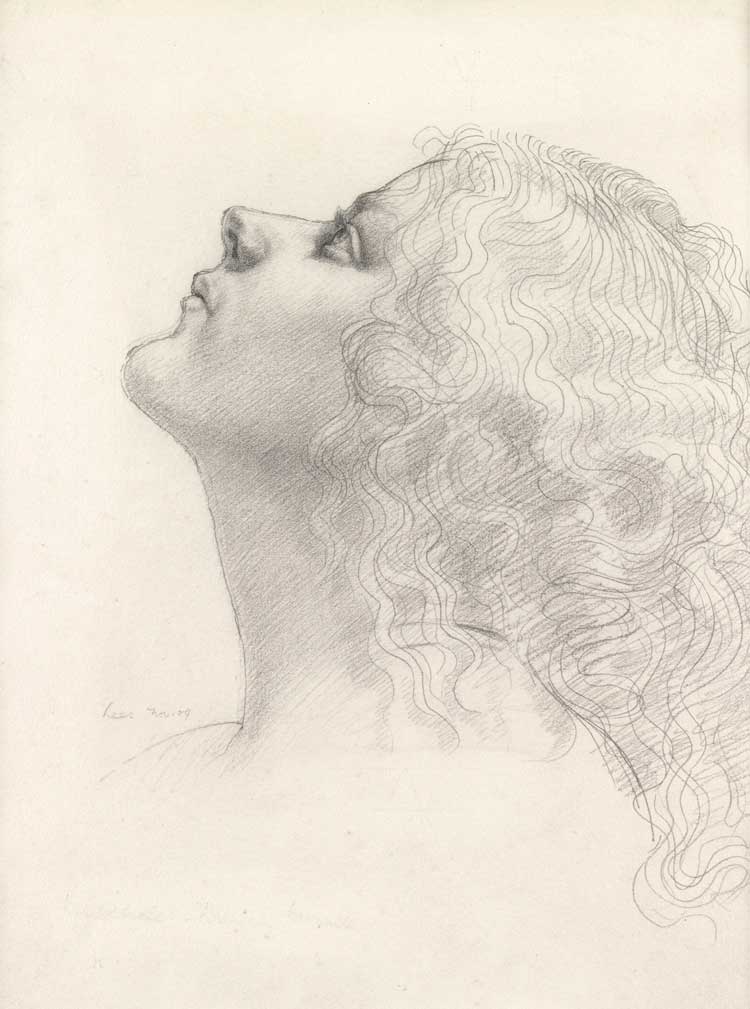
Derwent Lees, Lyndra, 1909. Graphite pencil on paper, 33 x 24.8 cm (13 x 9 3/4 in). Courtesy of Piano Nobile, London.
Upstairs and downstairs, across the two sites (Piano Nobile owns 96 and 129 Portland Road, which face one another on either side of the street), we are introduced, one by one, to these other friends of the John siblings: the sculptor Jacob Epstein; the Welsh painter James Dickson Innes; John’s closest student allies, Henry Lamb and William Orpen; the well-connected William Rothenstein; and the later vorticist Wyndham Lewis, who described John as “one who had gigantic earrings, a ferocious red beard, a large angry eye, and who barked beautifully at you from his proud six foot, and, marvellously, was a great artist too”.2 Many of the works are portraits, some of which are only peripherally related to the protagonists (such as Rothenstein’s sanguine pastel drawings of the writers EM Forster (1923), Thomas Hardy (1900) and Arthur Wing Pinero (1920)); others which depict the friends as seen by their friends (for example, Lees’s graphite drawing of Lyndra (1909), her head tipped back and her wavy hair cascading alluringly, alongside John’s, from one year later, titled Portrait of Edith Lees, in which she is looking down to the side, much more sternly focused, her jaw squarely set, and John’s striking red chalk Portrait of Percy Wyndham Lewis (c1905), made on a small page with a perforated edge, where it has been torn from a book). The peripherally related portraits are principally for sale, as Piano Nobile is a commercial gallery, but the portraits of friends have been borrowed from collectors to create a brilliant and well-curated show.
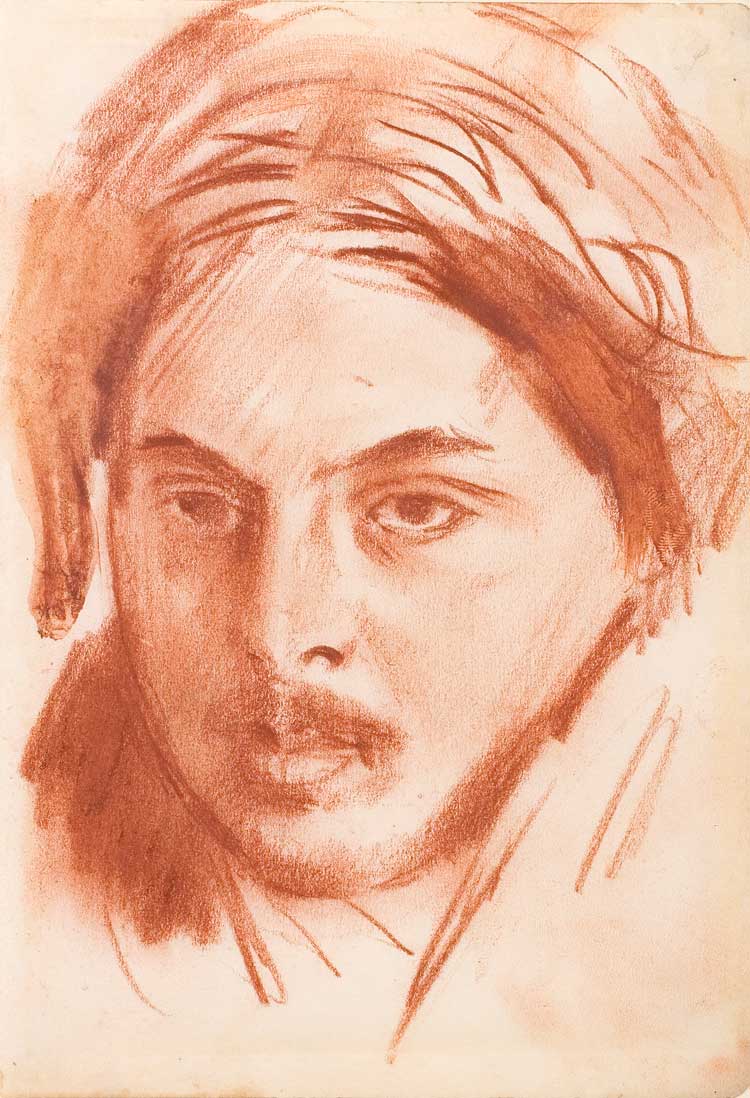
Augustus John, Portrait of Percy Wyndham Lewis, c1905. Red chalk on paper, 18.5 x 12.5 cm (7 1/4 x 4 3/4 in). © The Estate of Augustus John, courtesy of Piano Nobile, London.
As anyone who knows anything about Augustus John will be aware, he married his fellow student, the artist Ida Nettleship (who soon ceased her artistic output to become a housewife and mother and died young of puerperal fever after giving birth to her fifth child), but they lived in a ménage à trois with the artist and model Dorelia (born Dorothy) McNeill (who stayed with him until his death). Both these familiar faces recur on the gallery walls. John’s sparse but characterful Portrait of Ida (c1901), for example, is contrasted with Orpen’s red chalk drawing, Portrait of Ida Nettleship (1898), which, albeit in somewhat more detail, brings to life what is unquestionably the same face. John’s terse style was exemplary of the manner in which he and his contemporaries were taught at the Slade by the drawing master Henry Tonks, who forbade smudging and the use of erasers, insisting that effects of light, shadow and modelling be achieved through line alone. Tonks was pleased with this cohort of students and referred to their vision and technique as a “crisis of brilliance” – from whence this exhibition draws its title. Rothenstein further evinced John’s talent, later writing: “[John] brought me his drawings, which were truly remarkable; so remarkable that they put mine […] into the shade. Here was someone likely to do great work; for not only were his drawings of heads and of the nude masterly; he poured our compositions with extraordinary ease; he had copiousness which goes with genius, and he himself had the eager understanding, the imagination, the readiness for intellectual and physical adventure one associated with genius.”3
.jpg)
Augustus John. Dorelia, 1909. Graphite pencil on paper, 25.4 x 16.5 cm (10 x 6 1/2 in). Private Collection. Copyright The Artist.
John’s drawing, Dorelia Standing with Right Arm Above (1907), is a further example of his simple and strong use of line. The vertical strokes capture the folds and flow of her long bohemian skirt, while the heavy dashes in the pit of her raised arm contrast with the much gentler marks shaping her left breast and the complete absence of marks conjuring the curve of her right. Dorelia (c1907-09), in which she wears an open shirt over her dress, is far more domestic and less sensual, while Dorelia (1909), which focuses on her head, beautifully sculpting her downcast eyes and eyelids, and the fullness of her cherry lips, is described in the catalogue as “one of his finest”.4 There is also a fourth Dorelia, however – Dorelia Standing, Left Hand Pointing (1903-04) – which was made several years earlier by Gwen, probably as the two of them undertook to walk from London to Rome (they made it as far as Toulouse, hitching lifts and selling portraits along the way, before settling for a time – Gwen for the rest of her life – in Paris. The nature of their relationship is much speculated about, and it is often proposed that they, too, were lovers – or, certainly, that Gwen felt romantically inclined towards Dorelia, whether this was reciprocated or not.). This faint and delicate drawing, in which Dorelia’s hair is swept to the side by a gentle breeze, is, for some reason, hanging downstairs in the office and not included in the catalogue. It is, however, an absolute hidden gem.
Dorelia’s sister, Edie McNeill, appears as well, in the form of a painting by Lamb from 1911. He had taken a trip to Brittany, following in the footsteps of Paul Gauguin, and had taken Edie with him as a model. While the fingers of her left hand might, perhaps, be criticised as appearing rather chubby, the otherwise sparrow-like features and dark, Romany skin tone and hair, are, as the artist proclaimed in a letter to Lytton Strachey (of Bloomsbury renown), really quite “sublime”.5
.jpg)
Jacob Epstein, Romilly John, 1907. Bronze, Height 20.3 cm (8 in). Courtesy of Ben Uri Museum and Gallery.
Lamb’s wife (for a brief spell only), Euphemia, also appears a number of times in this exhibition. She is painted in a teal dress by Dickson Innes (c1909-11), drawn by her husband (1906) and Augustus John (1907) – who depicts her captivatingly, with her lips slightly parted, eyes downcast – and sculpted in bronze by Epstein (1911). A second bronze by this artist is a curious small head of Romilly John (conceived 1907), the son of Augustus and Dorelia. His cheeks are chubby like those of a toddler (Romilly was two when his father commissioned this bust to help his struggling friend financially), but his smooth, bobbed haircut makes it look as if he is wearing a crash helmet – perhaps not wholly unintentional, if you think of Epstein’s bionic Rock Drill (c1913-15) soon to come (although this was, of course, made in response to the horrors of the first world war); certainly a step towards modernist sculpture, characterised by formal austerity and anti-naturalism. John’s children frequently appeared in his and his friends’ works, something altogether unsurprising in the light of the rumour, fuelled by the artist’s promiscuity, that he fathered up to 100 offspring.
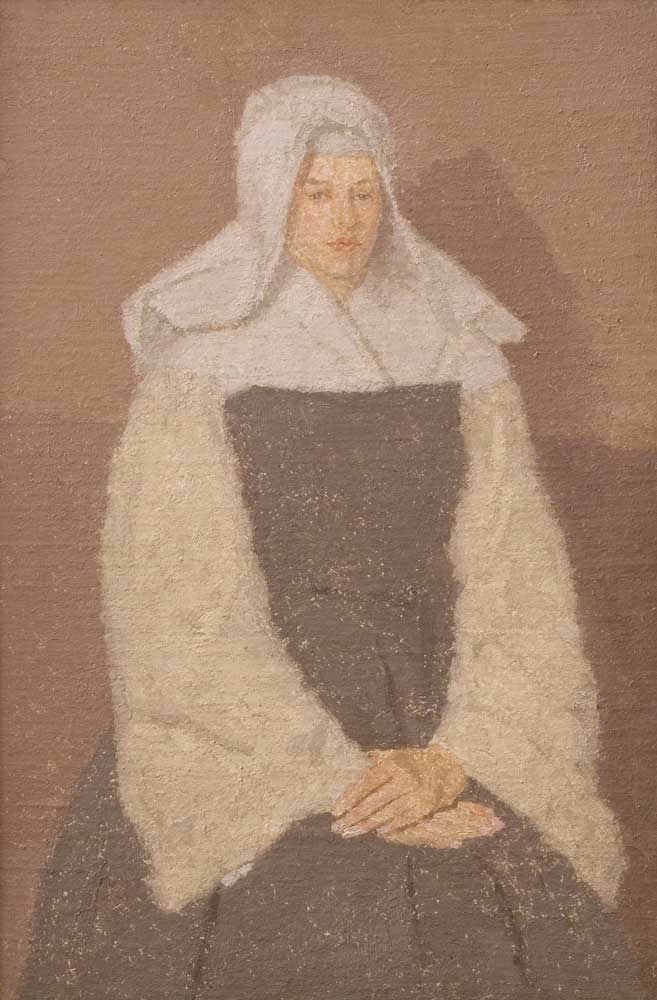
Gwen John, Portrait of a Young Nun, 1918-19. Oil on canvas, 60.3 x 40 cm (23 3/4 x 15 3/4 in). Private Collection.
Gwen John’s career and life, once she established herself in Paris, took a wholly different trajectory from that of her brother. Although portrayals of her as a shy recluse are now generally rejected, she converted to Catholicism in 1913, after the breakdown of her relationship with the sculptor – and her master – Auguste Rodin. In the following years, she made a great number of paintings of nuns from the order from which she took her instruction – some, commissioned, of the founder, Mère Marie Poussepin (working from a tiny prayer card, as she was long since dead); others of current sisters, in oil, watercolour and pencil. Here we see an oil, Portrait of a Young Nun (c1918-19) (which was displayed so brilliantly in the recent Pallant House Gallery exhibition, Gwen John: Art and Life in London and Paris, alongside several others from the series), and the candid snapshot in charcoal, watercolour and gouache, Sleeping Nun (c1916-18).
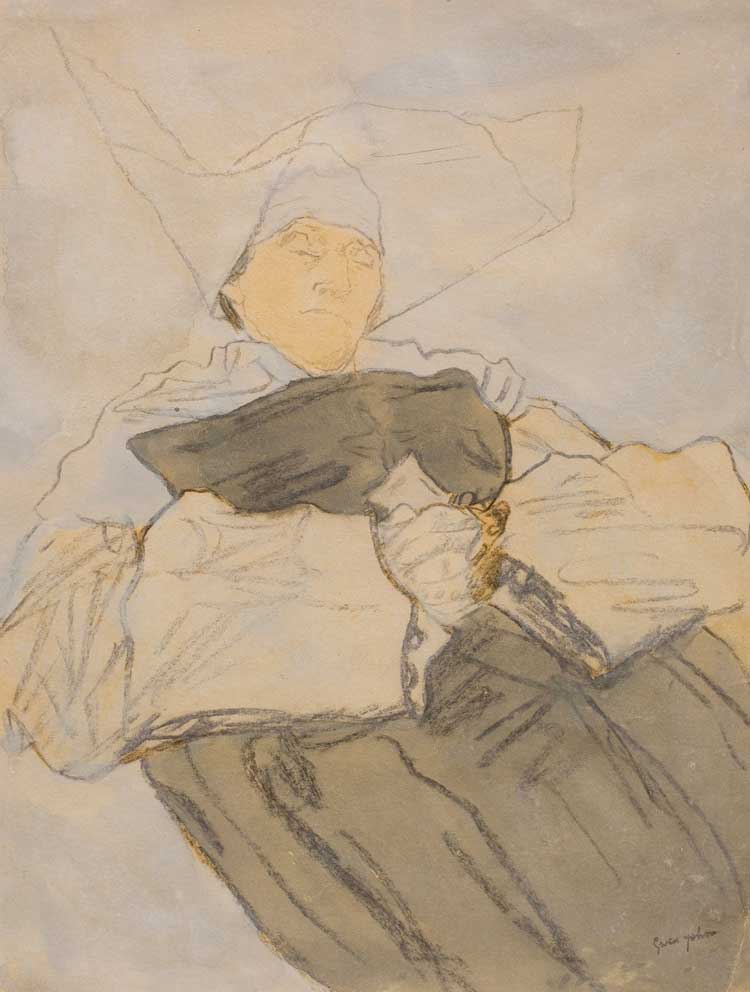
Gwen John, Sleeping Nun, 1916-18. Charcoal, watercolour and gouache, 31.8 x 23.8 cm (12 1/2 x 9 3/8 in). Private Collection. Courtesy of Piano Nobile, London.
Augustus John also painted people, and, between 1907 and 1914, the female figure – usually Dorelia – became a key motif in his work. His style became looser and more modern, with a freshness of colour to match the freshness of content. An example here is Girl in a Blue Striped Coat (c1910), in which the figure wears a bohemian red dress, with a green-and-blue-striped coat and a yellow scarf around her head. The use of primary and complementary colours, and the simple blocking of shapes and fields, captures youth, freedom and simplicity – values by which John and his (extended) family certainly lived. The stripes on the coat, the underskirt, and, to a lesser extent, the scarf, echo the use of line in his drawings.
There is also a room devoted to landscapes – mostly in Wales and the south of France, where John, Innes and Lees worked together for a time between 1911 and 1913. The same basic palette is perceived by each artist, albeit in radically different tones: whereas John’s mountain is lilac-purple, Innes’s is claret-red; and while John’s sky is bubble-gum pink with candyfloss clouds, Lamb’s (of Donegal) is an ominous thundery grey. It is interesting to compare and contrast, but I think I enjoyed it more with the faces than the places.
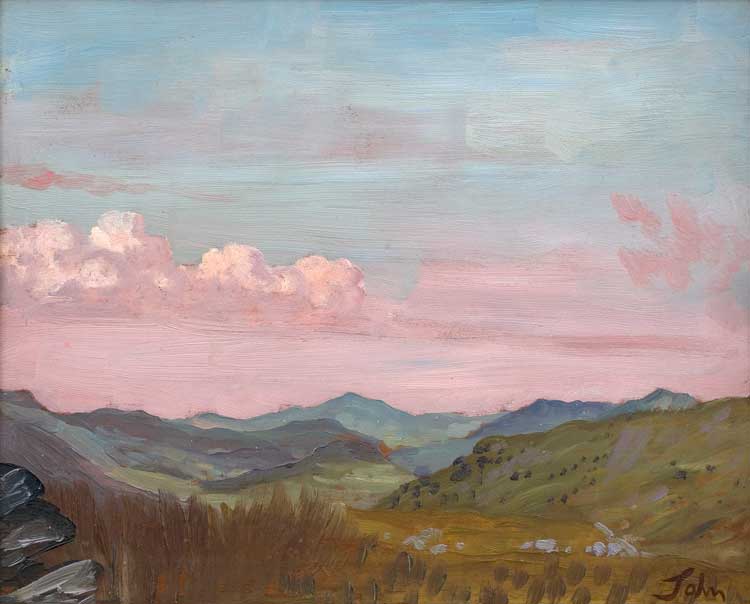
Augustus John, Landscape in Wales, c1911-13. Oil on panel, 32.5 x 40.6 cm (12 3/4 x 16 in). © The Estate of Augustus John, courtesy of Piano Nobile, London.
Lewis’s work is an interesting inclusion, being first not what one would typically think of as exemplary of him and, second, not really fitting with the other pictures and sculptures on display. The two pieces stem from Lewis’s time working with the Omega Workshops and comprise nine designs for Omega lampshades (1913) and, standing in the middle of one of the ground floor galleries, an embroidered and block-printed silk robe (1913-14). Lewis left the workshops following a disagreement in October 1913 and went on to establish the rival decorative workshop Rebel Art Centre and, later, the vorticist movement. His inclusion here is probably primarily to link with John’s portrait of him (mentioned above). John also loyally resigned from the Royal Academy in support of Lewis when his portrait of TS Eliot was rejected from the Summer Exhibition in 1938. Lewis’s praise of John went so far as his dubbing the years leading up to the first world war “the Augustan decade”, although he did later suggest that John’s subsequent work had not lived up to its promise.6
During their lifetimes, John significantly outperformed Lewis, but today, while there are at least two journals and a society dedicated to the study of Lewis’s art and writings, there are none to John.7 Indeed, even at the time, Rothenstein sometimes found it difficult to persuade collectors to buy John’s drawings. “It was not so much the indifference of the critics, of artists and collectors that angered me,” he recalled, “as their constant assertion that John couldn’t draw, that his work was ugly.”8 That his achievements were secondary to those of his sister, Augustus acceded from early on, noting: “In 50 years’ time I will be known as the brother of Gwen John.”9 This, for me, is indisputably borne out in the exhibition with Gwen’s drawing of Dorelia.
Nevertheless, Augustus John was the star around whom all these artists were in orbit, and what Piano Nobile has done here, bringing in loans to contextualise and paint a picture (literally) of the world in which John lived, to draw people in and boost interest in the works of his for sale, is clever, well orchestrated, and will hopefully pay off. For me, as someone purely interested in the viewing experience (with no intention of buying), the exhibition is well sized and well curated, is accompanied by a superb catalogue, and I was warmly received. This is an opportunity to grab by whatever means you can.
References
1. Chiaroscuro. Fragments of Autobiography: First Series by Augustus John, published by Jonathan Cape, London, 1952, page 49.
2. Augustus John and the First Crisis of Brilliance by David Boyd Haycock, exhibition catalogue, Piano Nobile, 2024, page 118.
3. Men and Memories: Recollections of William Rothenstein, 1872-1900 by William Rothenstein, published by Faber & Faber, London, 1931, pages 332-35, cited in ibid, page 34.
4. Exhibition catalogue, op cit, page 36.
5. Exhibition catalogue, op cit, page 56.
6. History of the Largest Independent Society in England by Wyndham Lewis in Blast, vol 2, July 1915, page 80, cited in exhibition catalogue, op cit, page 28.
7. Exhibition catalogue, op cit, page 104.
8. Rothenstein, op cit, page 340, cited in ibid, page 34.
9. Ten Things You Need To Know About Gwen John, Pallant House Gallery website.